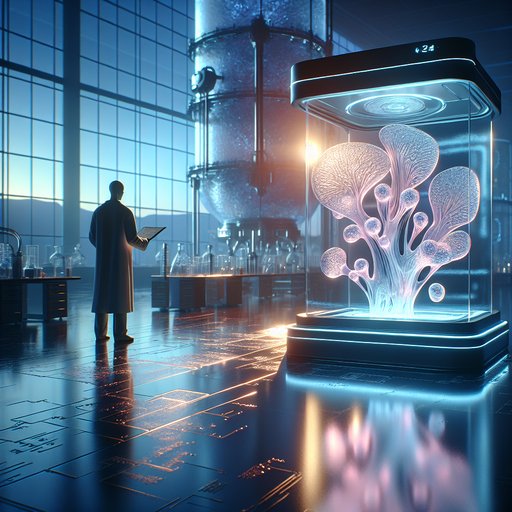
In a windowless room behind a pediatric cardiac ward, a machine draws filaments of shimmering, cell-rich gel into patterns that look like frost on glass, building a sliver of living tissue the color of a dawn bruise. It is not a heart, not yet, but it might strengthen one: an engineered patch for a child whose next birthday was never guaranteed. Down the hall, a researcher scrolls through a design that treats tissues as cities and capillaries as streets, while halfway around the world, a fermentation tank the size of a bus churns out the proteins that make the gel possible. Organ printing and synthetic biology are edging from promise to practice, changing how we treat disease and grow food, and quietly redrawing the boundaries of what a body is allowed to be.
The printer’s gantry whispers as it slides, laying down a spiral of hydrogel that glows faintly under violet light. A nurse peers through the porthole, checks a tablet, taps a line of code that nudges the deposition rate by a fraction. The room smells sterile and faintly sweet, like a museum of new plastic. On the stainless table is a small whiteboard list: perfusate warmed, substrate sterilized, backup nozzle loaded.
There is no romance here, no thunderclap of discovery—just the unshowy choreography of a team coaxing cells into a shape the body might accept. The lattice it forms is temporary and clever: scaffolding for a layer of patient-derived cardiac cells to occupy, capillaries etched like ivy vines along a trellis. Two floors up, the surgical team walks the boundary between wonder and caution. They talk about minutes of ischemia and the soft thresholds of pediatric hearts; they murmur about immune invisibility and the old arithmetic of rejection.
A decade ago, they would have pressed a thumb to a paper list of donors and waited. Now they read a file that describes how the cells were nudged toward cardiomyocytes, how the bio-inks were tuned to dissolve as the child’s own cells tug them apart. The language they use is clinical but edged with awe. Every new step is a negotiation with regulators and precedent, with the knowledge that medicine has a long memory for hubris.
In a light-drenched studio across town, a designer stands before a screen that treats tissue as topography. She drags a cursor and the software lays out a branching network with the pragmatism of a civil engineer—arterioles tapering like side streets, perfusion gradients calculated in muted blues and reds. The tool was born from game engines and chip design; constraints whisper to the user when a curve tightens too sharply for cells to thrive or when a chamber risks becoming a dead-end cul-de-sac. Behind the scenes, a library of cell behaviors sits like a palette—how fast they divide, how they hew to each other, what signals urge them to build, to stop, to specialize.
It is design as caretaker, coaxing function from form. None of this is conjured from thin air. In a warehouse that smells like warmed milk and metal, steel vessels line up like oversized thermoses, each one busy teaching microbes to knit molecules that used to come from animals. Collagen without cows.
Gelatin without hooves. Albumin spun from yeast. The broth burbles gently and a technician checks a readout, mindful that a small wobble in pH ripples into someone’s operating room next month. On pallets nearby, sterile cartridges wait to be shipped—a supply chain for living matter.
It is an odd kind of agriculture: stainless rather than soil, fermentation tanks instead of fields, but the same old anxieties about weather, downtime, pests now replaced by power outages, contamination alarms, and the cost of cold-chain miles. For the family down the corridor from the print room, the revolution is measured in the thud of shoes on linoleum and the cruel elasticity of time. The child with the fraying heart sleeps. A parent watches a cartoon on mute and pretends not to look at the vitals screen.
A social worker explains what the patch is meant to do: take strain off, buy time, help the heart learn to beat more evenly while other options—donation, more surgery, a life lived carefully—remain on the table. The language slips between science and hope. When the print finishes, the room’s temperature rises a fraction as technicians encourage the tiny channels to open. The patch moves almost imperceptibly under a microscope, a first rehearsal for the work of living.
Elsewhere, the same instincts are spilling into fields and factories. On the outskirts of a farm town, a pilot plot gleams under hoop houses, wheat that shares the soil with a carefully crafted microbial consortium. The goal is as old as agriculture: nourish plants without flooding them with nitrogen they must spend energy shedding. Sensors on sticks send back cautious optimism—greener blades, fewer runoff spikes after rain.
A farmer in a stiff cap watches with hands in pockets and says that a good season used to be just luck and sweat, and now it also depends on software updates and delivery timelines for microbes that, by design, do not linger. The line between tool and life blurs quietly as the wheat rises. For every breakthrough, there is a second door marked what if. In a basement three train stops from the hospital, a security team runs red-team drills that treat the new biology like the internet before firewalls were fashionable.
They simulate a design that misroutes a capillary bed, a cartridge swapped with a look-alike, a printer tweaked to over-extrude at a critical boundary. A whiteboard fills with countermeasures: DNA sequence screening at print houses, device firmware that cross-checks blueprints against physical performance, watermarks woven into cell lines to trace leaks like invisible ink. They talk like pilots with checklists, aware that there will be no applause if everything works, and no excuse if complacency takes root. At a public hearing in a town that has more breweries than churches, arguments about a new fermentation facility spill into the hallway.
Some say the tanks will make the town smell like bread and pay for the high school roof; others worry about pipelines of genetically modified yeast and the debts that come when a global supply chain hiccups. Microbiologists explain that it is yeast doing a job it has done for millennia with different scripts, and ecological monitors outline the nets and locks that make mishaps less likely. The tension in the room is not just about safety; it’s about belonging. A technology wants to move in and become a neighbor, and neighbors are assessing its table manners.
Beyond the headlines and hearings, the shape of access takes form. At a clinic in a crowded city with heat waves and rolling blackouts, a refrigerator coughs into life and a nurse counts cartridges with the focus of someone who knows scarcity well. The printer here is ruggedized, its delicate parts armored against dust and power surges. The team has learned to schedule prints at night when the grid is less stressed.
Outside, a sign advertises a lottery for a limited number of subsidized procedures—a bandage over a deeper wound. In a video call, engineers in another country talk through a fault and ship a part. The child on the list does not know about licensing models or patent pools, just that their name moves slowly and the calendar cannot be bribed. There are rooms these machines will not reach for a long time, and rituals that will not become obsolete.
On a hospital wall, a donor memorial shimmers with names, each one a story that ends and then seeds a dozen more. Families leave flowers and sometimes small paper cranes. Organ printing does not erase that gift; it complicates it, invites new questions. Who are we when our parts can be grown to order.
What does generosity mean when scarcity lifts its foot, even a little. The answer shifts each month as news from labs collides with the silent work of care teams and the long breath of public trust. Back in the print room, the machine rests, a hum fading into the kinds of sounds buildings make when no one is trying to listen. A technician scribbles a note and tapes it to the incubator.
The patch will be inspected in the morning, perfused again, evaluated as if it were both child and circuit. In the choreography of modern medicine, it is another step, a gesture toward a future where bodies are not only mended but iteratively improved. Whether that future arrives politely or with a jolt depends on choices being made now—in factories and farms, in quiet labs and noisy town halls. The heart keeps time, and the machines learn to follow without ever quite leading.








































